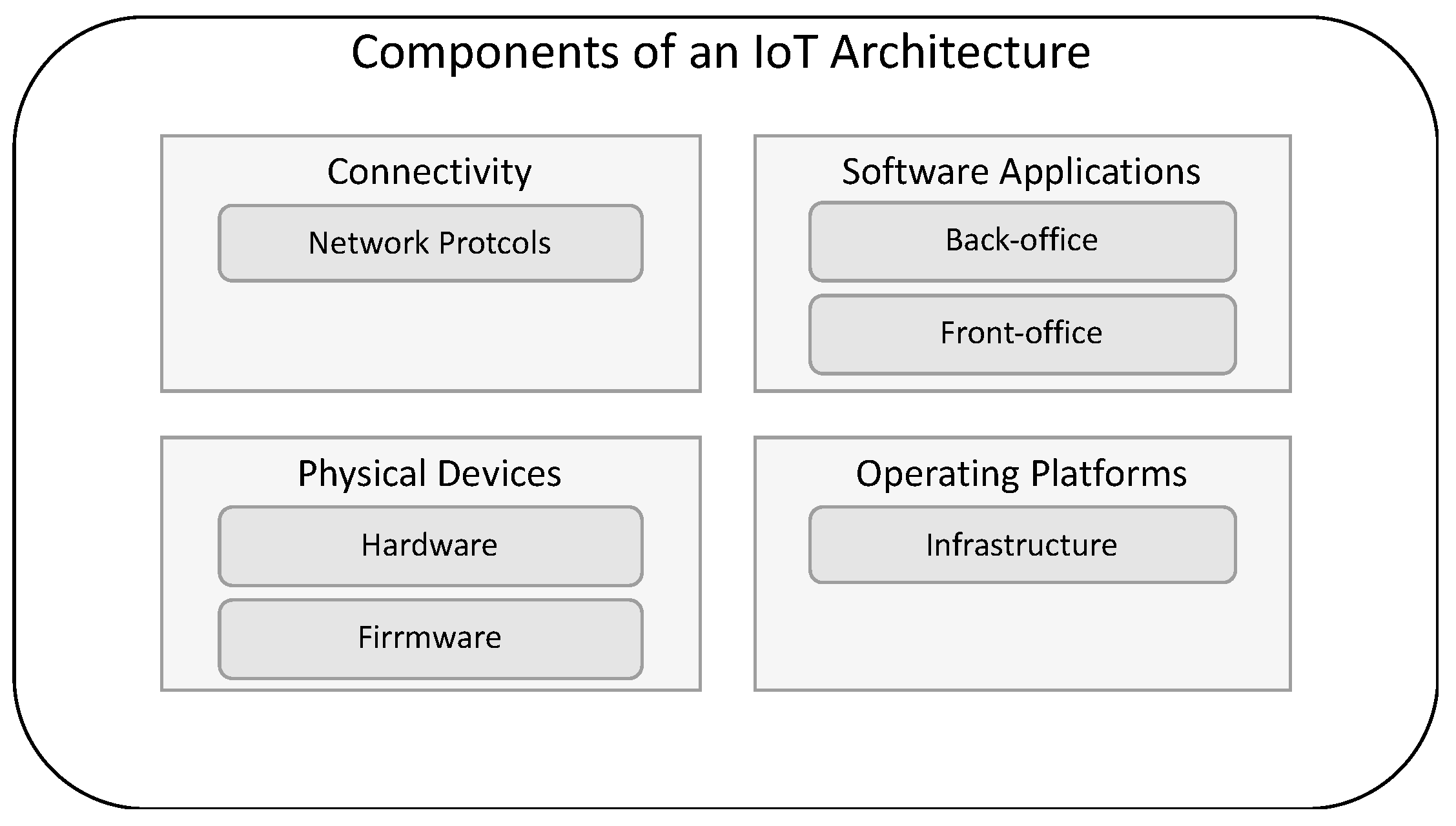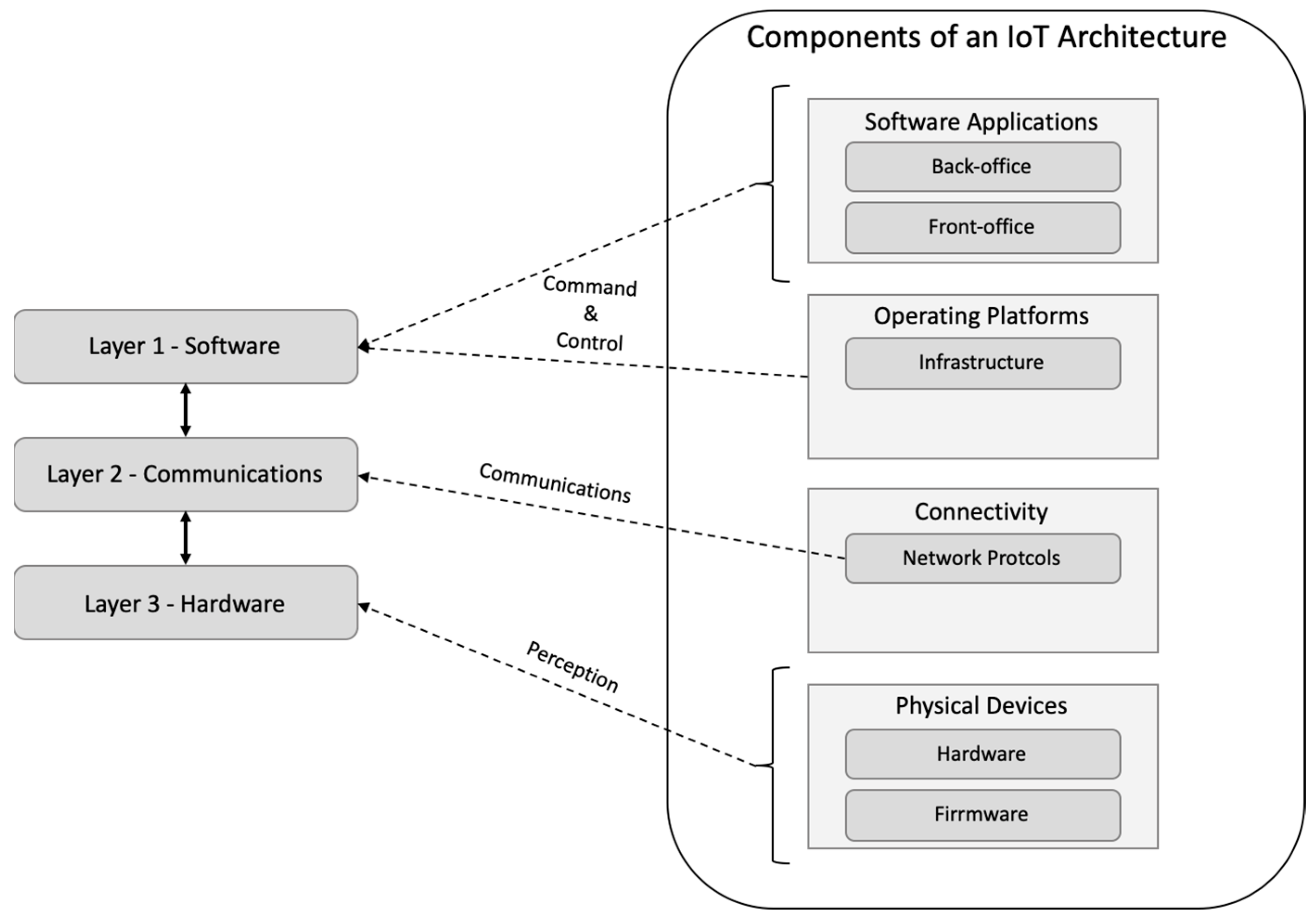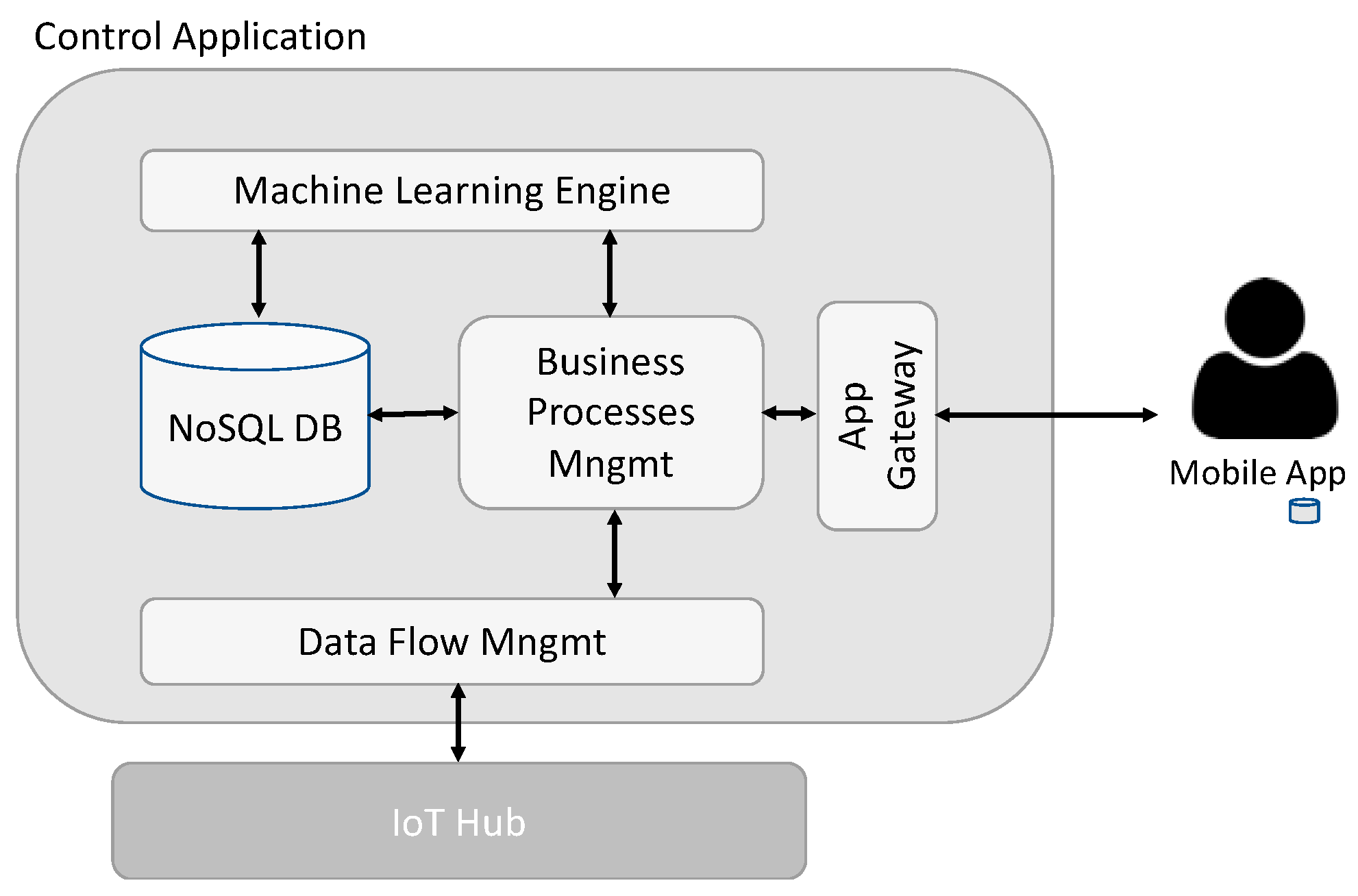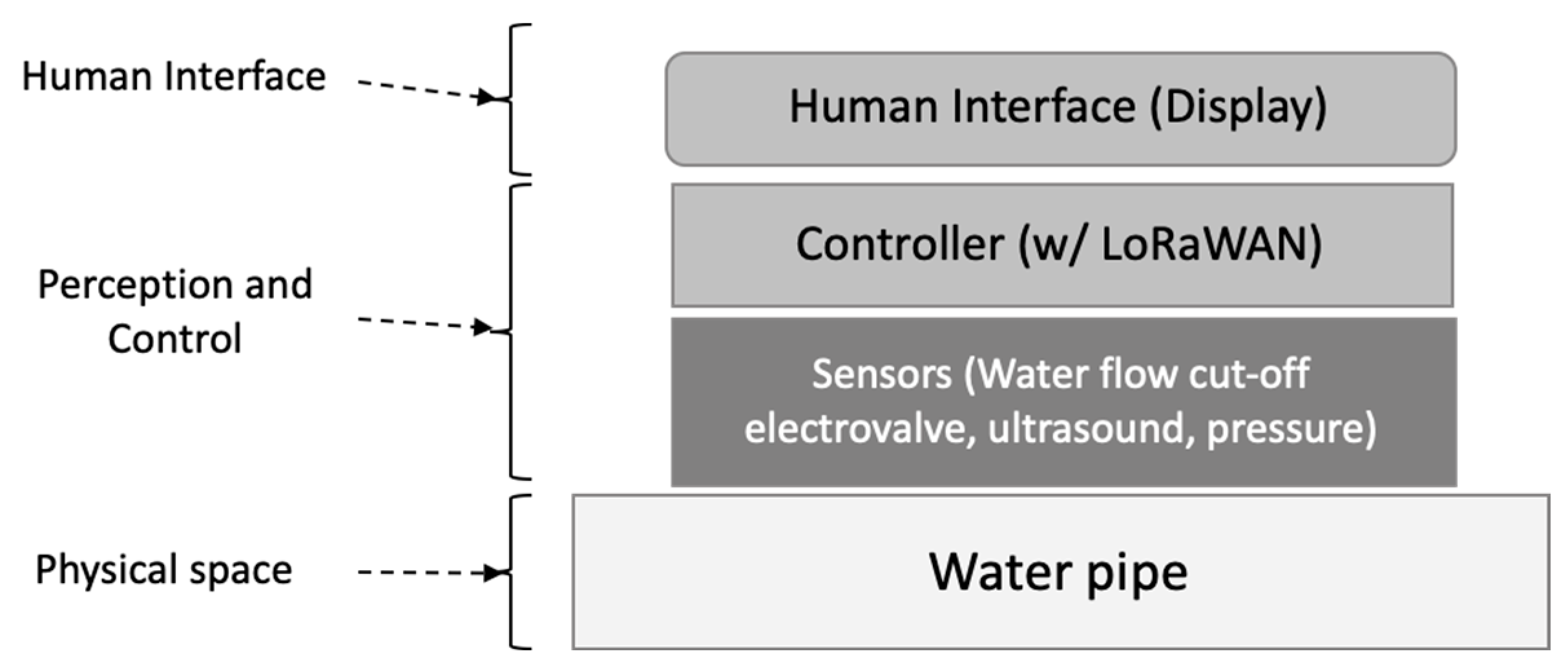A Prototype for an Intelligent Water Management System for Household Use
Abstract
1. Introduction
2. Water Management—Background Analysis
2.1. Water Leakage
2.2. Water Security
2.3. Water Management Digital Transition
3. Intelligent Water Monitoring System Proposal
3.1. Solution Requirements
- To the best of our knowledge, the existing literature needs to propose a water management solution to give the consumer instantaneous feedback on water consumption. Some existing solutions can collect data concerning water usage but not provide immediate feedback;
- Within the catalogue of analysed solutions and systems, no solution allowed for remote water flow control, as most of the researched solutions only addressed data collection concerning data usage;
- Although the proposal may seem promising, most of the revised models and architectures published in the existing literature have not been put into practice. Thus, whether they can effectively operate in a real-world setting remains to be demonstrated.
- Every piece of the solution must be as standard as possible;
- The solution will use only open and non-proprietary communication protocols;
- The solution must provide the ability to put the data/information in each user’s hand;
- The search for the solution must consider the transformation of the traditional water meter into an intelligent device;
- We may propose additional devices to complement the meter activity.
3.2. Solution Architecture
- Layer 1—Software, considering the requirements for an end-user solution able to fulfil the objectives and comply with the requirements;
- Layer 2—Communications, considering the usage of non-proprietary protocols and the need to support different approaches, thinking on a global perspective of later broad implementation;
- Layer 3—Hardware, defining and engineering the needed hardware to support the solution’s requirements.
Software Layer
3.3. Communications Layer
3.4. Hardware Layer
4. Solution at Work
- The quantity of water that flows back into the network from home infrastructure when a tap is opened and closed is not accurately measured;
- A mechanism must be developed to update the firmware of meters supported in the communications network to enable the application of corrections and updates without the need to dismantle and send them back to the factory.
5. Conclusions
5.1. Research Implications
5.2. Limitations and Future Research
5.3. Final Considerations
Author Contributions
Funding
Institutional Review Board Statement
Informed Consent Statement
Data Availability Statement
Acknowledgments
Conflicts of Interest
References
- Hunt, D.V.L.; Shahab, Z. Sustainable Water Use Practices: Understanding and Awareness of Masters Level Students. Sustainability 2021, 13, 10499. [Google Scholar] [CrossRef]
- Klosok-Bazan, I.; Boguniewicz-Zablocka, J.; Suda, A.; Łukasiewicz, E.; Anders, D. Assessment of Leakage Management in Small Water Supplies Using Performance Indicators. Environ. Sci. Pollut. Res. 2021, 28, 41181–41190. [Google Scholar] [CrossRef] [PubMed]
- Bello, O.; Abu-Mahfouz, A.; Hamam, Y.; Page, P.; Adedeji, K.; Piller, O. Solving Management Problems in Water Distribution Networks: A Survey of Approaches and Mathematical Models. Water 2019, 11, 562. [Google Scholar] [CrossRef]
- Mashhadi, N.; Shahrour, I.; Attoue, N.; El Khattabi, J.; Aljer, A. Use of Machine Learning for Leak Detection and Localization in Water Distribution Systems. Smart Cities 2021, 4, 1293–1315. [Google Scholar] [CrossRef]
- Jabbar, W.A.; Alsibai, M.H.; Amran, N.S.S.; Mahayadin, S.K. Design and Implementation of IoT-Based Automation System for Smart Home. In Proceedings of the 2018 International Symposium on Networks, Computers and Communications (ISNCC), Rome, Italy, 19–21 June 2018; IEEE: New York, NY, USA; pp. 1–6. [Google Scholar]
- Rupiper, A.; Weill, J.; Bruno, E.; Jessoe, K.; Loge, F. Untapped Potential: Leak Reduction Is the Most Cost-Effective Urban Water Management Tool. Environ. Res. Lett. 2022, 17, 34021. [Google Scholar] [CrossRef]
- El-Zahab, S.; Zayed, T. Leak Detection in Water Distribution Networks: An Introductory Overview. Smart Water 2019, 4, 5. [Google Scholar] [CrossRef]
- Su, Y.; Gao, W.; Guan, D.; Zuo, T. Achieving Urban Water Security: A Review of Water Management Approach from Technology Perspective. Water Resour. Manag. 2020, 34, 4163–4179. [Google Scholar] [CrossRef]
- World Economic Forum. The Global Risks Report 2022, 17th ed.; World Economic Forum: Cologny, Switzerland, 2022; ISBN 978-2-940631-09-4. [Google Scholar]
- FAO. Water Scarcity. Available online: https://www.fao.org/land-water/water/water-scarcity/en/ (accessed on 28 December 2022).
- Chen, Y.; Cen, G.; Hong, C.; Liu, J.; Lu, S. A Metric Model on Identifying the National Water Scarcity Management Ability. Water Resour. Manag. 2018, 32, 599–617. [Google Scholar] [CrossRef]
- Brown, L.R. How Water Scarcity Will Shape the New Century. Water Sci. Technol. 2001, 43, 17–22. [Google Scholar] [CrossRef]
- Veldkamp, T.I.E.; Wada, Y.; Aerts, J.; Döll, P.; Gosling, S.N.; Liu, J.; Masaki, Y.; Oki, T.; Ostberg, S.; Pokhrel, Y. Water Scarcity Hotspots Travel Downstream Due to Human Interventions in the 20th and 21st Century. Nat. Commun. 2017, 8, 15697. [Google Scholar] [CrossRef]
- Navarro-Ortega, A.; Acuna, V.; Bellin, A.; Burek, P.; Cassiani, G.; Choukr-Allah, R.; Dolédec, S.; Elosegi, A.; Ferrari, F.; Ginebreda, A. Managing the Effects of Multiple Stressors on Aquatic Ecosystems under Water Scarcity. The GLOBAQUA Project. Sci. Total Environ. 2015, 503, 3–9. [Google Scholar] [CrossRef] [PubMed]
- Hussain, Z.; Wang, Z.; Wang, J.; Yang, H.; Arfan, M.; Hassan, D.; Wang, W.; Azam, M.I.; Faisal, M. A Comparative Appraisal of Classical and Holistic Water Scarcity Indicators. Water Resour. Manag. 2022, 36, 931–950. [Google Scholar] [CrossRef]
- Nguyen, T.T.; Ngo, H.H.; Guo, W.; Wang, X.C.; Ren, N.; Li, G.; Ding, J.; Liang, H. Implementation of a Specific Urban Water Management—Sponge City. Sci. Total Environ. 2019, 652, 147–162. [Google Scholar] [CrossRef] [PubMed]
- Yu, X.; Geng, Y.; Heck, P.; Xue, B. A Review of China’s Rural Water Management. Sustainability 2015, 7, 5773–5792. [Google Scholar] [CrossRef]
- Sapkota, M.; Arora, M.; Malano, H.; Moglia, M.; Sharma, A.; George, B.; Pamminger, F. An Overview of Hybrid Water Supply Systems in the Context of Urban Water Management: Challenges and Opportunities. Water 2014, 7, 153–174. [Google Scholar] [CrossRef]
- Hoffmann, S.; Feldmann, U.; Bach, P.M.; Binz, C.; Farrelly, M.; Frantzeskaki, N.; Hiessl, H.; Inauen, J.; Larsen, T.A.; Lienert, J.; et al. A Research Agenda for the Future of Urban Water Management: Exploring the Potential of Nongrid, Small-Grid, and Hybrid Solutions. Environ. Sci. Technol. 2020, 54, 5312–5322. [Google Scholar] [CrossRef]
- Wilderer, P.A. Applying Sustainable Water Management Concepts in Rural and Urban Areas: Some Thoughts about Reasons, Means and Needs. Water Sci. Technol. 2004, 49, 7–16. [Google Scholar] [CrossRef]
- Giustiziero, G.; Kretschmer, T.; Somaya, D.; Wu, B. Hyperspecialization and Hyperscaling: A Resource-Based Theory of the Digital Firm. Strateg. Manag. J. 2021, 42, 1–34. [Google Scholar] [CrossRef]
- Zekri, S.; Jabeur, N.; Gharrad, H. Smart Water Management Using Intelligent Digital Twins. Comput. Inform. 2022, 41, 135–153. [Google Scholar] [CrossRef]
- Martins, J.; Gonçalves, C.; Silva, J.; Gonçalves, R.; Branco, F. Digital Ecosystem Model for GIAHS: The Barroso Agro-Sylvo-Pastoral System. Sustainability 2022, 14, 10349. [Google Scholar] [CrossRef]
- Obringer, R.; Nateghi, R. What Makes a City ‘Smart’ in the Anthropocene? A Critical Review of Smart Cities under Climate Change. Sustain. Cities Soc. 2021, 75, 103278. [Google Scholar] [CrossRef]
- Oberascher, M.; Rauch, W.; Sitzenfrei, R. Towards a Smart Water City: A Comprehensive Review of Applications, Data Requirements, and Communication Technologies for Integrated Management. Sustain. Cities Soc. 2022, 76, 103442. [Google Scholar] [CrossRef]
- Quadar, N.; Chehri, A.; Jeon, G.; Ahmad, A. Smart Water Distribution System Based on IoT Networks, a Critical Review. In Human Centred Intelligent Systems; Smart Innovation, Systems and Technologies; Zimmermann, A., Howlett, R.J., Jain, L.C., Eds.; Springer: Singapore, 2021; Volume 189, pp. 293–303. ISBN 9789811557835. [Google Scholar]
- Singh, M.; Ahmed, S. IoT Based Smart Water Management Systems: A Systematic Review. Mater. Today Proc. 2021, 46, 5211–5218. [Google Scholar] [CrossRef]
- Miller, M.; Kisiel, A.; Cembrowska-Lech, D.; Durlik, I.; Miller, T. IoT in Water Quality Monitoring—Are We Really Here? Sensors 2023, 23, 960. [Google Scholar] [CrossRef]
- Ismail, S.; Dawoud, D.W.; Ismail, N.; Marsh, R.; Alshami, A.S. IoT-Based Water Management Systems: Survey and Future Research Direction. IEEE Access 2022, 10, 35942–35952. [Google Scholar] [CrossRef]
- Khambati, A.; Pinto, K.; Joshi, D.; Karamchandani, S.H. Innovative Smart Water Management System Using Artificial Intelligence. Turk. J. Comput. Math. Educ. TURCOMAT 2021, 12, 4726–4734. [Google Scholar] [CrossRef]
- Rojek, I. Models for Better Environmental Intelligent Management within Water Supply Systems. Water Resour. Manag. 2014, 28, 3875–3890. [Google Scholar] [CrossRef]
- Xiang, X.; Li, Q.; Khan, S.; Khalaf, O.I. Urban Water Resource Management for Sustainable Environment Planning Using Artificial Intelligence Techniques. Environ. Impact Assess. Rev. 2021, 86, 106515. [Google Scholar] [CrossRef]
- Krishnan, S.R.; Nallakaruppan, M.K.; Chengoden, R.; Koppu, S.; Iyapparaja, M.; Sadhasivam, J.; Sethuraman, S. Smart Water Resource Management Using Artificial Intelligence—A Review. Sustainability 2022, 14, 13384. [Google Scholar] [CrossRef]
- Suciu, G.; Bezdedeanu, L.; Vasilescu, A.; Suciu, V. Unified Intelligent Water Management Using Cyberinfrastructures Based on Cloud Computing and IoT. In Proceedings of the 2017 21st International Conference on Control Systems and Computer Science (CSCS), Bucharest, Romania, 29–31 May 2017; IEEE: New York, NY, USA; pp. 606–611. [Google Scholar]
- Savic, D.; Bicik, J.; Morley, M.; Duncan, A.; Kapelan, Z.; Djordjević, S.; Keedwell, E. Intelligent Urban Water Infrastructure Management. J. Indian Inst. Sci. 2013, 93, 319–336. [Google Scholar]
- Robles, T.; Alcarria, R.; Martin, D.; Morales, A.; Navarro, M.; Calero, R.; Iglesias, S.; Lopez, M. An Internet of Things-Based Model for Smart Water Management. In Proceedings of the 2014 28th International Conference on Advanced Information Networking and Applications Workshops, Victoria, BC, Canada, 13–16 May 2014; IEEE: New York, NY, USA; pp. 821–826. [Google Scholar]
- Sammaneh, H.; Al-Jabi, M. IoT-Enabled Adaptive Smart Water Distribution Management System. In Proceedings of the 2019 International Conference on Promising Electronic Technologies (ICPET), Gaza City, Palestine, 23–24 October 2019; IEEE: New York, NY, USA; pp. 40–44. [Google Scholar]
- Abdeljebbar, N.; Moussaid, L.; Medromi, H. Smart Water Management: Pillars and Technologies. In Big Data and Smart Digital Environment; Studies in Big Data; Farhaoui, Y., Moussaid, L., Eds.; Springer: Cham, Switzerland, 2019; Volume 53, pp. 7–14. ISBN 978-3-030-12047-4. [Google Scholar]
- Manoharan, H.; Basha, A.R.; Teekaraman, Y.; Manoharan, A. Smart Home Autonomous Water Management System for Agricultural Applications. World J. Eng. 2020, 17, 445–455. [Google Scholar] [CrossRef]
- Nasir, M.; Muhammad, K.; Ullah, A.; Ahmad, J.; Baik, S.W.; Sajjad, M. Enabling Automation and Edge Intelligence over Resource Constraint IoT Devices for Smart Home. Neurocomputing 2022, 491, 494–506. [Google Scholar] [CrossRef]
- Priyadharsini, K.; Dhanushmathi, S.; Dharaniga, M.; Dharsheeni, R.; Dinesh Kumar, J. Ease and Handy Household Water Management System. In Intelligent Data Communication Technologies and Internet of Things: Proceedings of ICICI 2021; Springer: Berlin/Heidelberg, Germany, 2022; pp. 75–91. [Google Scholar]
- Almulhim, A.I.; Aina, Y.A. Understanding Household Water-Use Behavior and Consumption Patterns during COVID-19 Lockdown in Saudi Arabia. Water 2022, 14, 314. [Google Scholar] [CrossRef]
- Kamienski, C.; Soininen, J.-P.; Taumberger, M.; Dantas, R.; Toscano, A.; Salmon Cinotti, T.; Filev Maia, R.; Torre Neto, A. Smart Water Management Platform: IoT-Based Precision Irrigation for Agriculture. Sensors 2019, 19, 276. [Google Scholar] [CrossRef]
- Kannan, N.; Anandhi, A. Water Management for Sustainable Food Production. Water 2020, 12, 778. [Google Scholar] [CrossRef]
- Yasin, H.M.; Zeebaree, S.R.M.; Sadeeq, M.A.M.; Ameen, S.Y.; Ibrahim, I.M.; Zebari, R.R.; Ibrahim, R.K.; Sallow, A.B. IoT and ICT Based Smart Water Management, Monitoring and Controlling System: A Review. Asian J. Res. Comput. Sci. 2021, 8, 42–56. [Google Scholar] [CrossRef]
- Shahady, T. Sustainable Water Management with a Focus on Climate Change. In Water and Climate Change; Elsevier: Amsterdam, The Netherlands, 2022; pp. 293–316. ISBN 978-0-323-99875-8. [Google Scholar]
- Gupta, B.B.; Quamara, M. An Overview of Internet of Things (IoT): Architectural Aspects, Challenges, and Protocols. Concurr. Comput. Pract. Exp. 2020, 32, e4946. [Google Scholar] [CrossRef]
- Ray, P.P. A Survey on Internet of Things Architectures. J. King Saud Univ.—Comput. Inf. Sci. 2018, 30, 291–319. [Google Scholar] [CrossRef]
- Sethi, P.; Sarangi, S.R. Internet of Things: Architectures, Protocols, and Applications. J. Electr. Comput. Eng. 2017, 2017, 9324035. [Google Scholar] [CrossRef]
- Choudhary, G.; Jain, A.K. Internet of Things: A Survey on Architecture, Technologies, Protocols and Challenges. In Proceedings of the 2016 International Conference on Recent Advances and Innovations in Engineering (ICRAIE), Jaipur, India, 23–25 December 2016; IEEE: New York, NY, USA; pp. 1–8. [Google Scholar]
- Patel, K.K.; Patel, S.M.; Scholar, P. Internet of Things-IOT: Definition, Characteristics, Architecture, Enabling Technologies, Application & Future Challenges. Int. J. Eng. Sci. Comput. 2016, 6, 1482. [Google Scholar]
- Muccini, H.; Moghaddam, M.T. IoT Architectural Styles: A Systematic Mapping Study. In Software Architecture; Lecture Notes in Computer, Science; Cuesta, C.E., Garlan, D., Pérez, J., Eds.; Springer International Publishing: Cham, Switzerland, 2018; Volume 11048, pp. 68–85. ISBN 978-3-030-00760-7. [Google Scholar]
- MSFT. Microsoft Azure IoT. Available online: https://azure.microsoft.com/cloud/iot (accessed on 10 January 2023).
- Al-Masri, E.; Kalyanam, K.R.; Batts, J.; Kim, J.; Singh, S.; Vo, T.; Yan, C. Investigating Messaging Protocols for the Internet of Things (IoT). IEEE Access 2020, 8, 94880–94911. [Google Scholar] [CrossRef]
- Iqbal, M.; Abdullah, A.Y.M.; Shabnam, F. An Application Based Comparative Study of LPWAN Technologies for IoT Environment. In Proceedings of the 2020 IEEE Region 10 Symposium (TENSYMP), Dhaka, Bangladesh, 5–7 June 2020; IEEE: New York, NY, USA; pp. 1857–1860. [Google Scholar]
- Sarker, V.K.; Queralta, J.P.; Gia, T.N.; Tenhunen, H.; Westerlund, T. A Survey on LoRa for IoT: Integrating Edge Computing. In Proceedings of the 2019 Fourth International Conference on Fog and Mobile Edge Computing (FMEC), Rome, Italy, 10–13 June 2019; IEEE: New York, NY, USA; pp. 295–300. [Google Scholar]
- Strzoda, A.; Grochla, K.; Frankiewicz, A.; Laskarzewski, Z. Measurements and Analysis of Large Scale LoRa Network Efficiency. In Proceedings of the 2022 International Wireless Communications and Mobile Computing (IWCMC), Dubrovnik, Croatia, 30 May–3 June 2022; IEEE: New York, NY, USA; pp. 818–823. [Google Scholar]








| Reference | Comments |
|---|---|
| [30,31,32,33] | Do not propose real working systems, but a data-based solution for consumption prediction over a certain number of households and for decision-making on water distribution. |
| [34,35] | Propose one IoT solution at the distribution level (high-pressure), not the consumer level (low-pressure). |
| [36] | Discussion about the lack of industry standards for water management |
| [37] | Water distribution management in a specific situation where every home possesses a tank. |
| [38] | Smart water management pillars in the context of smart cities. |
| Requirement | Impact on Water Management |
|---|---|
| Every piece of the solution must be as standard as possible | Using standard elements will impact the time to market any developed solution and the time to repair when needed. In this way, any problem caused by failure or lack of the device is minimised. |
| The solution will use only open and non-proprietary communication protocols | Using non-proprietary protocols will facilitate network coverage and make the communication process cheaper while minimising the risks of failure of connections and, consequently, the exchange of information and commands between devices and the cloud application. |
| The solution must provide the ability to put the data/information in the hand of each user | Suppose each user, at any given moment, can understand their consumption and have a solution that minimises losses through leakages and other problems of a similar nature. In that case, we will have the individual capacity to manage water. |
| The search for the solution must take into consideration the transformation of the traditional water meter into an intelligent device | A smart meter will allow each user to carry out individual water management, providing them with data for decision making and the tools capable of independently acting in an emergency. |
| We may propose additional devices to complement the meter activity | Additional devices allow greater granularity of information to the consumer, superior installation protection, and greater precision. |
| Requirement | Addressed by |
|---|---|
| Every piece of the solution must be as standard as possible. | Software layer based on Microsoft IoT Framework; communications supported in LoRaWAN; hardware uses a standard controller and devices from the market. |
| The solution will use only open and non-proprietary communication protocols. | Communications supported in LoRaWAN. |
| The solution must provide the ability to put the data/information in each user’s hand. | Mobile application that connects to Control Application, allowing the user to consume data and interact with devices. |
| The search for our solution must take into consideration the transformation of the traditional water meter into an intelligent device. | The device can shut down the water by itself; the control application provides data and recommendations for better water usage. |
| We may propose additional devices to complement the meter activity. | A small device has been developed for local leak detection, completing the solution. |
| Water Consumption (in Litres) | |||||||
|---|---|---|---|---|---|---|---|
| Characteristics | Number of Persons | Last 12 Months (Monthly Average) | Month 1 | Month 2 | Month 3 | Month 4 | |
| Property 1 | Villa w/garden | 3 | 17,600 | 15,710 | 14,860 | 14,310 | 13,770 |
| Property 2 | Villa w/garden | 4 | 23,200 | 20,265 | 19,678 | 18,678 | 18,045 |
Disclaimer/Publisher’s Note: The statements, opinions and data contained in all publications are solely those of the individual author(s) and contributor(s) and not of MDPI and/or the editor(s). MDPI and/or the editor(s) disclaim responsibility for any injury to people or property resulting from any ideas, methods, instructions or products referred to in the content. |
© 2023 by the authors. Licensee MDPI, Basel, Switzerland. This article is an open access article distributed under the terms and conditions of the Creative Commons Attribution (CC BY) license (https://creativecommons.org/licenses/by/4.0/).
Share and Cite
Mamede, H.; Neves, J.C.; Martins, J.; Gonçalves, R.; Branco, F. A Prototype for an Intelligent Water Management System for Household Use. Sensors 2023, 23, 4493. https://doi.org/10.3390/s23094493
Mamede H, Neves JC, Martins J, Gonçalves R, Branco F. A Prototype for an Intelligent Water Management System for Household Use. Sensors. 2023; 23(9):4493. https://doi.org/10.3390/s23094493
Chicago/Turabian StyleMamede, Henrique, João Cortez Neves, José Martins, Ramiro Gonçalves, and Frederico Branco. 2023. "A Prototype for an Intelligent Water Management System for Household Use" Sensors 23, no. 9: 4493. https://doi.org/10.3390/s23094493
APA StyleMamede, H., Neves, J. C., Martins, J., Gonçalves, R., & Branco, F. (2023). A Prototype for an Intelligent Water Management System for Household Use. Sensors, 23(9), 4493. https://doi.org/10.3390/s23094493













